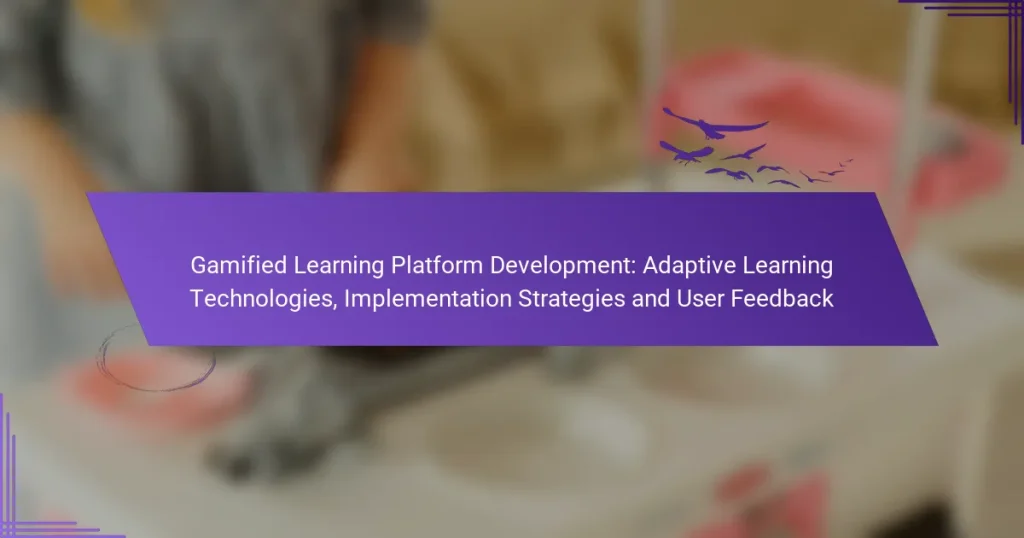Gamified learning platforms leverage adaptive learning technologies to create engaging and personalized educational experiences. By incorporating game mechanics, these platforms motivate learners while tailoring content to their individual needs and preferences. Effective implementation requires aligning game elements with educational goals and fostering user engagement through rewards, social features, and real-time feedback.

What are the best gamified learning platforms for adaptive learning?
The best gamified learning platforms for adaptive learning include tools that engage users through interactive elements while personalizing the learning experience. These platforms utilize game mechanics to motivate learners and adapt content based on individual performance and preferences.
Kahoot!
Kahoot! is a popular platform that allows educators to create interactive quizzes and games. It promotes active participation through real-time feedback and competitive elements, making learning enjoyable. Users can customize quizzes to adapt to different learning levels, ensuring that content is relevant and engaging.
To maximize its effectiveness, consider incorporating a mix of question types, such as multiple-choice and true/false, to cater to various learning styles. Avoid overly complex questions that may confuse learners, and keep quizzes concise to maintain engagement.
Quizlet
Quizlet offers a versatile approach to gamified learning with flashcards, quizzes, and interactive games. It allows users to create study sets tailored to their needs, making it suitable for a wide range of subjects. The platform’s adaptive learning features help identify areas where users may need additional practice.
Utilize Quizlet’s various study modes, such as Learn and Test, to reinforce knowledge retention. Be mindful of setting realistic study goals and regularly updating study sets to reflect new material or concepts.
Edmodo
Edmodo is a social learning platform that combines gamification with classroom management tools. It enables teachers to create assignments, share resources, and foster collaboration among students. The platform’s adaptive features allow for personalized learning experiences based on student progress.
To effectively use Edmodo, encourage students to engage with peers through discussions and group projects. Avoid overwhelming students with too many assignments at once, and ensure that feedback is timely and constructive to enhance learning outcomes.
Classcraft
Classcraft transforms the learning environment into a role-playing game where students earn points and rewards for positive behaviors and academic achievements. This platform fosters collaboration and motivation, as students work together to complete quests and challenges. Its adaptive learning features allow for tailored experiences based on student performance.
Incorporate Classcraft into your curriculum by setting clear objectives and rewards for achievements. Be cautious not to focus solely on competition; emphasize teamwork and collective success to create a supportive learning atmosphere.
Duolingo
Duolingo is a language-learning platform that gamifies the process through bite-sized lessons and interactive exercises. Its adaptive learning technology adjusts the difficulty based on user performance, ensuring that learners are challenged appropriately. The platform’s engaging interface keeps users motivated to practice regularly.
To get the most out of Duolingo, set daily practice goals and utilize the app’s reminders to stay on track. Avoid skipping lessons, as consistent practice is key to language retention and fluency.

How to implement gamified learning technologies effectively?
To implement gamified learning technologies effectively, focus on aligning game elements with educational goals while ensuring user engagement. This involves defining clear learning objectives, selecting suitable game mechanics, integrating adaptive learning algorithms, and testing the system through a pilot program.
Define learning objectives
Establishing clear learning objectives is crucial for effective gamified learning. These objectives should be specific, measurable, achievable, relevant, and time-bound (SMART). For example, instead of a vague goal like “improve math skills,” specify “increase algebra test scores by 20% within three months.”
Involve stakeholders, including educators and learners, in the objective-setting process to ensure alignment with user needs and expectations. This collaboration can enhance motivation and engagement, leading to better outcomes.
Choose appropriate game mechanics
Selecting the right game mechanics is essential for fostering engagement and motivation. Common mechanics include points, badges, leaderboards, and challenges. For instance, a points system can reward learners for completing tasks, while badges can signify achievements and milestones.
Consider the target audience when choosing mechanics. Younger learners may respond better to colorful graphics and immediate rewards, while adult learners might prefer more complex challenges and recognition of their achievements. Balance simplicity with depth to maintain interest.
Integrate adaptive learning algorithms
Adaptive learning algorithms personalize the educational experience by adjusting content based on individual performance. These algorithms analyze user interactions and learning patterns to provide tailored resources and challenges. For example, if a learner struggles with a specific topic, the system can offer additional practice or alternative explanations.
Implementing adaptive technologies requires robust data collection and analysis capabilities. Ensure that privacy regulations, such as GDPR in Europe, are followed when handling user data. This approach not only enhances learning outcomes but also increases user satisfaction.
Test with a pilot program
Conducting a pilot program is a critical step in validating the effectiveness of the gamified learning platform. Start with a small group of users to gather feedback and identify potential issues. This can help refine the platform before a wider rollout.
During the pilot, collect qualitative and quantitative data on user engagement, learning outcomes, and technical performance. Use surveys and analytics tools to assess user satisfaction and areas for improvement. Adjust the platform based on this feedback to enhance its effectiveness and user experience.

What are the key strategies for user engagement in gamified learning?
Key strategies for user engagement in gamified learning include incorporating rewards, utilizing social features, providing real-time feedback, and fostering competition. These elements create an interactive and motivating environment that enhances the learning experience.
Incorporate rewards and badges
Incorporating rewards and badges into a gamified learning platform can significantly boost user motivation. Users often feel a sense of achievement when they earn badges for completing tasks or reaching milestones. Consider implementing a tiered badge system, where users can earn different levels of badges based on their progress.
Rewards can also be tangible, such as discounts on future courses or access to exclusive content. This dual approach encourages continued participation and enhances the overall learning experience.
Utilize social learning features
Utilizing social learning features fosters collaboration and community among users. Features like discussion forums, group projects, and peer reviews allow learners to interact, share insights, and support each other. This social interaction can lead to deeper understanding and retention of the material.
Encouraging users to form study groups or participate in challenges together can also enhance engagement. Platforms should consider integrating social media sharing options to extend the learning community beyond the platform itself.
Provide real-time feedback
Providing real-time feedback is crucial for maintaining user engagement in gamified learning. Instant feedback helps learners understand their performance and areas for improvement, making the learning process more effective. Consider using automated quizzes or interactive exercises that offer immediate results.
Additionally, personalized feedback can be more impactful. Implementing adaptive learning technologies that tailor feedback based on individual performance can enhance user satisfaction and learning outcomes.
Foster competition through leaderboards
Fostering competition through leaderboards can motivate users to engage more deeply with the learning material. Leaderboards create a sense of achievement and encourage users to strive for higher rankings. It’s important to ensure that the competition is healthy and inclusive, allowing users of all skill levels to participate.
Consider implementing different types of leaderboards, such as weekly challenges or skill-based rankings, to keep the competition fresh and exciting. This approach can drive continuous engagement and encourage users to return regularly to improve their scores.

What are the challenges in gamified learning platform development?
Gamified learning platform development faces several challenges, including the need to balance engagement with educational effectiveness, technical integration, accessibility for diverse users, and measuring learning outcomes. Addressing these issues is crucial for creating a successful and impactful platform.
Balancing fun and educational value
Creating a gamified learning experience requires a careful balance between entertainment and educational content. While engaging elements like rewards and competition can motivate users, they must not overshadow the learning objectives. Developers should integrate game mechanics that reinforce educational goals, such as using quizzes as part of gameplay.
One effective approach is to employ a feedback loop where users receive immediate responses to their actions, enhancing both enjoyment and knowledge retention. For example, incorporating levels that correspond to learning milestones can keep users motivated while ensuring they achieve educational outcomes.
Technical integration issues
Technical integration poses significant challenges in developing a gamified learning platform. Developers must ensure that various components, such as learning management systems, databases, and user interfaces, work seamlessly together. Compatibility with existing technologies and platforms is essential to avoid disruptions.
To mitigate integration issues, it is advisable to adopt open standards and APIs that facilitate communication between different systems. Regular testing and updates can help identify and resolve potential conflicts early in the development process.
Ensuring accessibility for all users
Accessibility is a critical consideration in gamified learning platform development. The platform must cater to users with varying abilities, including those with visual, auditory, or cognitive impairments. Implementing features like text-to-speech, adjustable font sizes, and alternative navigation methods can enhance usability for all learners.
Following established accessibility guidelines, such as the Web Content Accessibility Guidelines (WCAG), can help ensure compliance and inclusivity. Regular user testing with diverse groups can provide valuable insights into how to improve accessibility further.
Measuring learning outcomes
Measuring learning outcomes in a gamified environment can be complex but is essential for assessing effectiveness. Developers should implement analytics tools that track user progress, engagement levels, and knowledge retention. This data helps refine the platform and improve educational strategies.
Using a combination of formative assessments, such as quizzes and interactive tasks, alongside summative assessments, can provide a comprehensive view of user learning. Establishing clear metrics for success, such as completion rates and skill acquisition, will guide ongoing improvements to the platform.

What criteria should be used to evaluate gamified learning platforms?
To evaluate gamified learning platforms effectively, consider criteria such as user engagement, educational effectiveness, adaptability, and user feedback. These factors help determine how well the platform meets learning objectives and user needs.
User experience and interface design
User experience (UX) and interface design are critical in gamified learning platforms as they directly impact user engagement and satisfaction. A well-designed interface should be intuitive, allowing learners to navigate easily without frustration. Consider using familiar design patterns to enhance usability.
Incorporating elements such as clear instructions, visually appealing graphics, and responsive design can significantly improve the overall experience. For example, using gamification elements like progress bars or achievement badges can motivate users and provide a sense of accomplishment.
When evaluating UX, gather user feedback through surveys or usability testing. Look for common pain points and areas for improvement, ensuring that the platform evolves based on user experiences and preferences.


